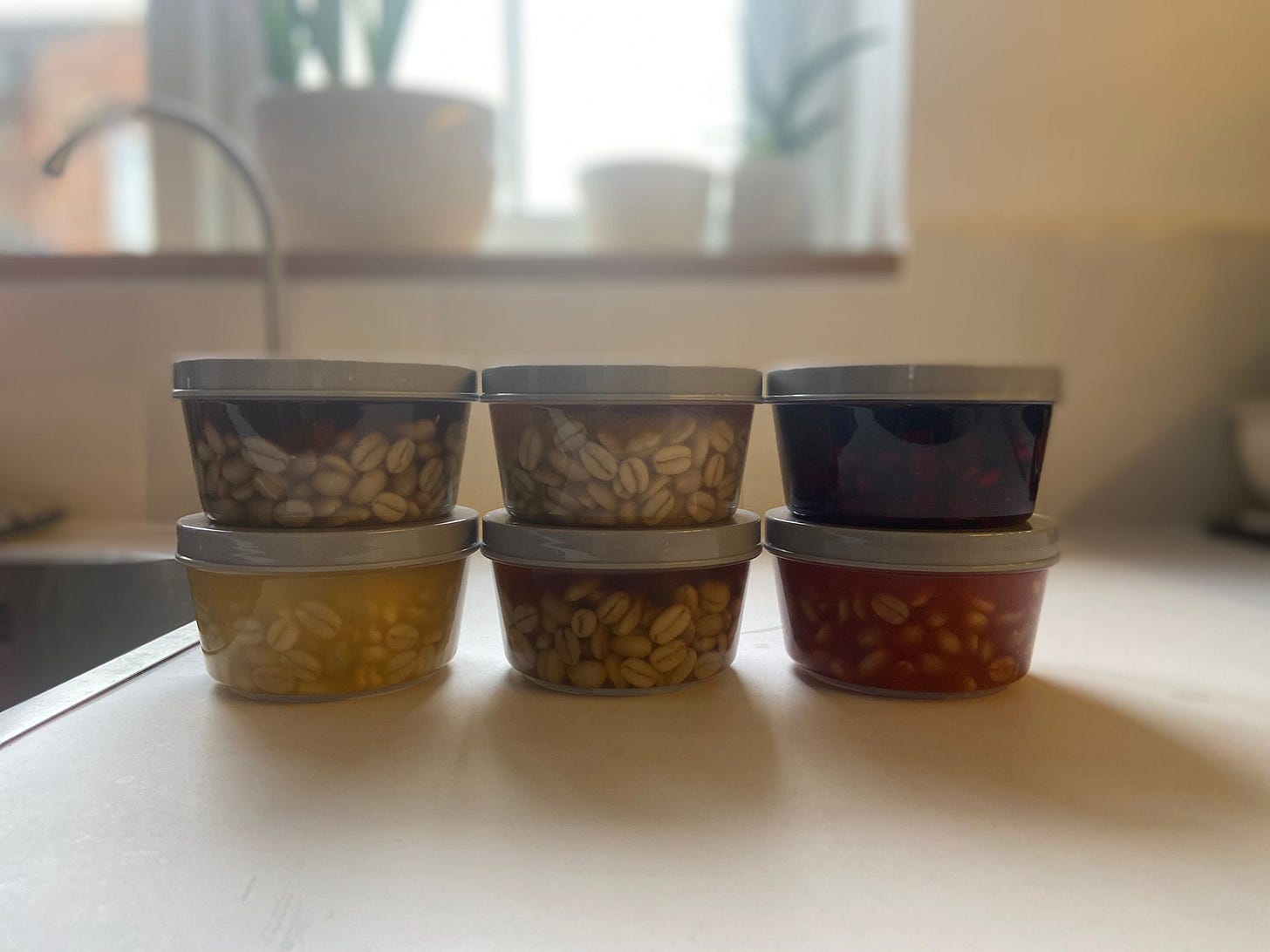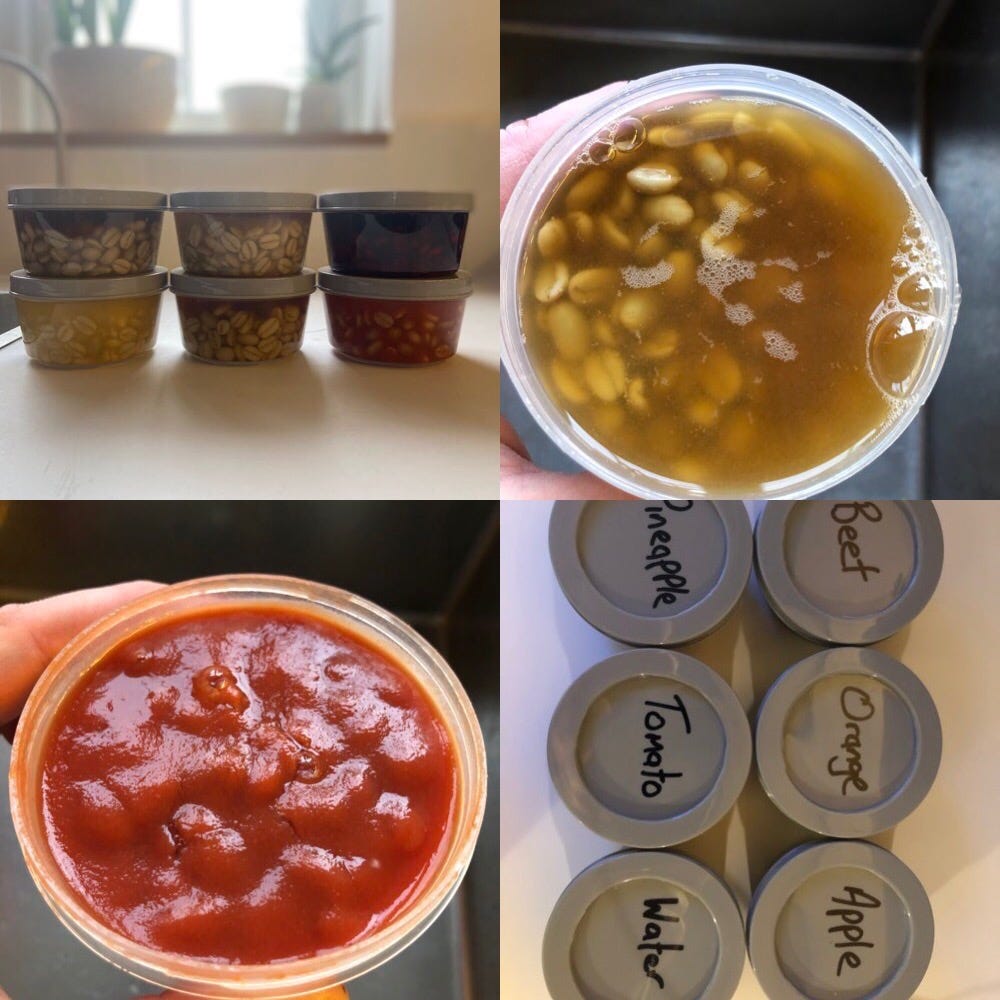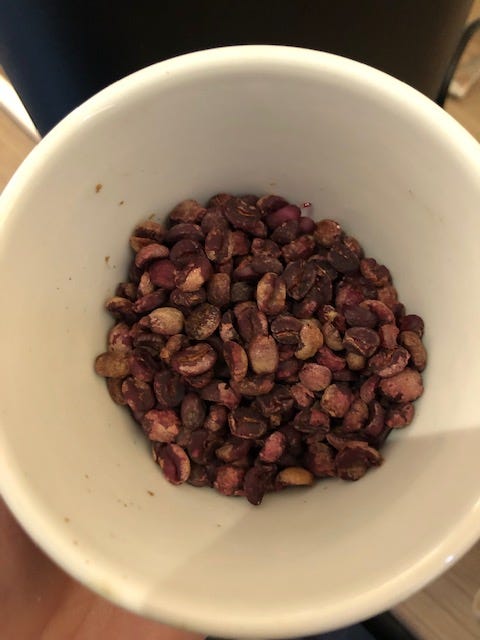Are you ready for a little “back of the envelope” science? Well, here goes…
A few months ago I read an extremely intriguing ARTICLE on the efficacy of rehydrating coffee seeds. This incredibly in-depth piece lays out the idea that if you submerge processed coffee seeds in water, and rehydrate them to higher moisture levels, then there could be a possibility to unlock the potential for the coffee to taste as good as it did when it was fresh off the drying table and potentially mitigate some undesirable elements of age.
My experience with tasting super fresh, high-moisture coffee at source has always been an interesting exercise, and although this has provided me with some truly unique tasting experiences, I have always favoured coffees that have had time to rest and homogenize as the freshness always tended to be a little too green and grassy for my tastebuds. (Still good, just green)
I am now starting to think that my over-exposure to coffee, dried to more stable levels of moisture, has led to my less-than-favourable interactions with super-fresh coffee. I am now mulling over the possibility that my over-familiarity with tasting too many batches of well-rested and stable lots has somehow created a little (FOMO).
Anyway, the article linked above and the subsequent ARTICLES that FOLLOWED have got me a little intrigued, to say the least so, much so, that I have been quietly turning my cupping space into a bio-hazard for the last few weeks.
Now I would like to point out, that this novel experiment is in no way my idea. Aparantly, people have been dehydrating and rehydrating foodstuff for a considerbaly LONG TIME, and although I do not lay claim to the inception of the experiment, I do enjoy examining the odd theory from time to time. I consdier myself a lifelong student in the field of coffee, and I view the exploration of ideas concieved by human beings that have more experience and academic prowess than I curently attain, as a very important luxury. So, in the name of “science”, the search for progress, and the urge to rehydrate. I decided to submerge some seeds in a little Juju…. Juice.
Coffee is a perishable commodity (believe it or not) that needs to travel a considerable journey before it reaches the cups of its largest-consuming countries. Drying coffee is an integral part of the coffee processing cycle and it is widely accepted that a range between 8% - 12% moisture is a stable point for the coffee to travel.
Some would argue that LESS MOISTURE is more appropriate but, if you look at this from a basic economic standpoint, less moisture ultimately means more seeds per sack. For producers, this can have a negative impact on what is already a low-margin game, and from my own experiences on the subject, this can also have a negative impact on flavour. As a roaster, the higher the moisture level in this range, the better. The only problem is this: with more moisture comes an unstable environment for some undesirable outcomes to take hold.
Coffee - loves - water.
Or anything else it comes in contact with, for that matter. Coffee is Hygroscopic and readily absorbs the majority of substances it finds itself swamped in. One crucial step we have seen from the rise of specialty coffee is the need to wrap our seeds in HERMETICALLY sealed environments in order to protect the integrity of the coffee as it travels. This cosy environment, if kept at stable temperatures and humidity should allow the seeds to reach their destination with little to no signs of degradation and have the desirable amount of moisture available in order to be harnessed later in the roaster.
What interested me was the idea that rehydrating coffee could potentially prolong the shelf life of the coffee seed and remove some of the elements of what the industry terms FADE. As a rule, coffee tends to start tasting woody when it is past its best, and as the coffee loses moisture over time, along with it goes a large majority of the VOLATILE COMPOUNDS, responsible for creating the chemical reactions that produce the desirable aromatic and flavour qualities when roasted.
Too much moisture is also bad…
The most obvious of the problems with high moisture coffee is that it creates a perfect environment for those volatile organic compounds to become unstable, and if exposed to abnormal conditions with a hefty amount of oxygen this can lead to ENZYMATIC issues that result in the creation of phenolic compounds that produce undesirable qualities when heat is applied. So, you can see why moisture is a knife edge that needs to be controlled and most exporters will have safe legal limits that need to be monitored before coffee can be shipped.
The experiment.
I became aware of the effects of rehydration when researching the piece I wrote on KENYAN coffee. an excellent article on SODA rehydration really fascinated me, and I blame the reading of this piece ( possibly over a hundred times) as the reason I decided to drop down this rabbit hole. However, my biggest takeaway from this, and where this has guided me over the last couple of months, is an interesting look into the current ideas of our industry and an insight into the critical thinkers who are shaping its future.
The idea was simple.
Instead of using soda, I would use “fresh” fruit juice to soak my beans.
I took an average score (84 point) mild, El Salvadorian coffee, that landed in the UK in May 2022. I checked the current moisture level. Which was still a solid 10.8% (Hail the grainpro?)
I weighed out 6 batches of 50g samples and soaked these in 100 ml of various fruit juices, with 1 sample soaked in filtered water. All samples were submerged for 12 hours. They were:
Beetroot
Orange
Apple
Pineapple
Tomato
Water
I then washed the samples with clean filtered water, laid the samples onto parchment, and then popped them in the dehydrator. This was set at 30 degrees for 4-hour intervals with an 8-hour rest in between each drying phase until I reached my desired 12.5% of moisture. This took a total of 6 drying cycles to be achieved.
Once the samples had rested for a couple of days, I then roasted the samples on my Ikawa, using the same profile I use for all of my samples and followed my standard cupping protocol. I also roasted a batch of the original coffee to be used as the control.
A few observations - before we get into the cupping results.
The first thing that stood out to me, when removing the seeds from their soak, was the observation of what looked like the start of seed germination. I am not sure if the seed was trying to reproduce? and although the urge was there to do further research on coffee seed reproduction I felt it necessary to nip this search for a later date. - Very interesting though.
The beans, after soaking, were swollen to the size of freshly pulped coffee seeds. I achieved just over 16% moisture in all of the samples after soaking although I am not 100% sure what the moisture content is after pulping. So maybe not the same size as fresh pulped?
Washing the seeds from their soak was an arduous task which I feel was not completed thoroughly, I found it extremely difficult to remove all of the residual liquid from the seeds after soaking and this certainly played a significant part in the roasting process.
The drying was slow and sticky, with lots of syrupy residue left on the parchment paper throughout the drying cycles, caused by potential washing problems after soaking? This reminded me of seeing honey processed coffee on the drying tables.
Roasting the seeds resulted in the soaked samples taking on a more developed colour of the outer bean. When ground the agtron reading was medium. This was an interesting development and I believe the residual sugars from the juice had attached to the outer seed causing this effect. This was to become apparent on tasting.
Cupping evaluation.
Below are my notes from the evaluation. I cupped under protocol, I coded the samples and performed the analysis blind. It felt slightly absurd being this rigorous considering I knew the samples had been dipped in juice. However, It did make for an interesting analysis.
Sample 1:
Aroma: Sweet, toffee apple, red-pepper, brown sugar.
Flavour: Strong acetic acid, caramel, cranberry, medium texture.
83.75Sample 2:
Aroma: Sweet, Milk Chocolate, Praline, Cashew.
Flavour: Sweet, stewed fruit, nuts, heavy mouthfeel, slight papery taste.
84.5Sample 3:
Aroma: Fruit leather, earthy,
Flavour: Creamy, extremely balanced, dark chocolate, savoury.
84Sample 4:
Aroma: Intense sweetness, fruit pastels, Balsamic.
Flavour: Sour, sharp, vegetal, pea-like quality with astringency. Medium weight.
83.25Sample 5:
Aroma: Woody, grain-like, Cereal, hazelnut
Flavour: Orange bitters, peanut, woody, caramel. Low weight.
83Sample 6:
Aroma: Ripe Orange, Dark Chocolate, Maple Syrup.
Flavour: Vibrant acidity, citric, dark chocolate, light body with slight astringency.
83.25Sample 7:
Aroma: Earthy, Savoury, Meat-like. Weird.
Flavour: Sweet, meaty, mild acidity but pleasing, fresh soil, damp earth.
82.75
1, Pineapple
2, Water
3, Tomato
4, Apple
5, Control
6, Orange
7, Beetroot
Conclusion.
Although I kind of knew what the outcome would be, I do feel there are a few key points to take away from this slightly ridiculous exercise and on further reflection and some extra research, I now know that sugar is way too big of a MOLECULE to permeate the cells of this little seed. (Vinegar, however, is not) something for later, maybe?
The cupping was interesting and the lack of adequate washing did lead to some flavour enhancement in the roasting however, this I believe was due to the sugars binding to the surface of the seed. This did cause problems in the roasting and I would describe the development of colour during the roast to be too high causing a little roast defect. This did not impart too much of a significant impact on flavour but did cause the samples to have some signs of astringency, this was interesting because, on physical inspection after roasting, the seeds looked very dark.
Orange was by far the most dominant flavour enhancer and I did enjoy the tomato cup for its balance and surprisingly achieved the second-highest score. The obvious result was that the seeds soaked in water gained .5 points on the original cup score from when the coffee had first landed in the UK and the control sample which scored 83 in this cupping was definitely showing signs of age. (Soaking could work, maybe?)
All of the juice-soaked samples did alter the flavour and produce a higher cup score than the control but, the majority of the juice samples, especially the apple juice sample, were just too sweet and added a somewhat synthetic sweetness and high acidity that would not make for an enjoyable full-cup experience.
My final words on the whole experiment would be that although I found the experience to be somewhat chaotic in my less-than-clinical approach, I did enjoy the process. What I would say is this, in my honest opinion, I do not feel there was any added value to the coffee and although the experiment was never intended to be a viable commercial exercise and the tomato coffee was indeed a pleasant surprise, what this experiment did achieve was a view into the reality of how extremely important, and difficult it is to get post-harvest processing practices finely tuned in order for coffee to reach us in a stable manner and with excellent flavour attributes. My respect for the producers of specilaty coffee is one of extremely high regard and we really need to be reminded of the skill that goes into producing truly excellent coffee.
My parting words would be to buy coffee as fresh as you possibly can and leave the processing to the experts. No value at all was added here but I do understand the desire to maintain freshness for as long as possible.
I certainly won’t be rehydrating coffee for a while.
I will maybe try freezing green coffee next time.
Another incredibly interesting week.
Burts.












I’m surprised that greater moisture content at the beginning of the roasting process results in a better cup. Would’ve assumed the opposite was true.
Hi Matthew,
It is a complicated set of principles when it comes to moisture.
Too much is indeed bad at the beginning of the roasting process. Driving off too much moisture in the initial phase of roasting could lead to an extended drying phase and longer roasts, potentially baking the coffee. This tends to leave the coffee tasting flat and hollow.
12% moisture however , is deemed acceptable for a couple of reasons.
1, likelihood of bacteria and fungus production is significantly reduced if stored and handled correctly.
2, there is enough moisture present to allow adequate heat transfer in the initial stages of the roast, this will dictate the rate at which specific chemical reactions take place that build flavour and aroma in the later stages.
Too little moisture will speed up the rate of heat transfer, and can lead to quick roasts that tend to cause underdevelopment. Cooked on the outside but raw on the inside.
It is a constant battle to manage.
Water is good - water is bad - water is life...
Thanks for reading and taking the time to comment. It is much appreciated.